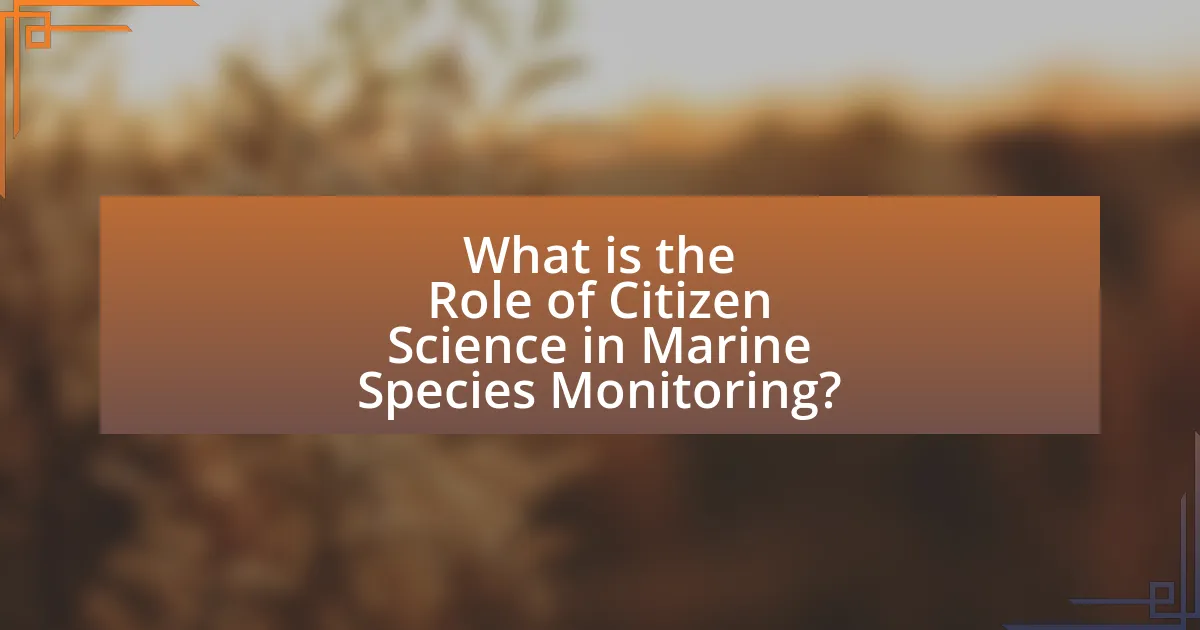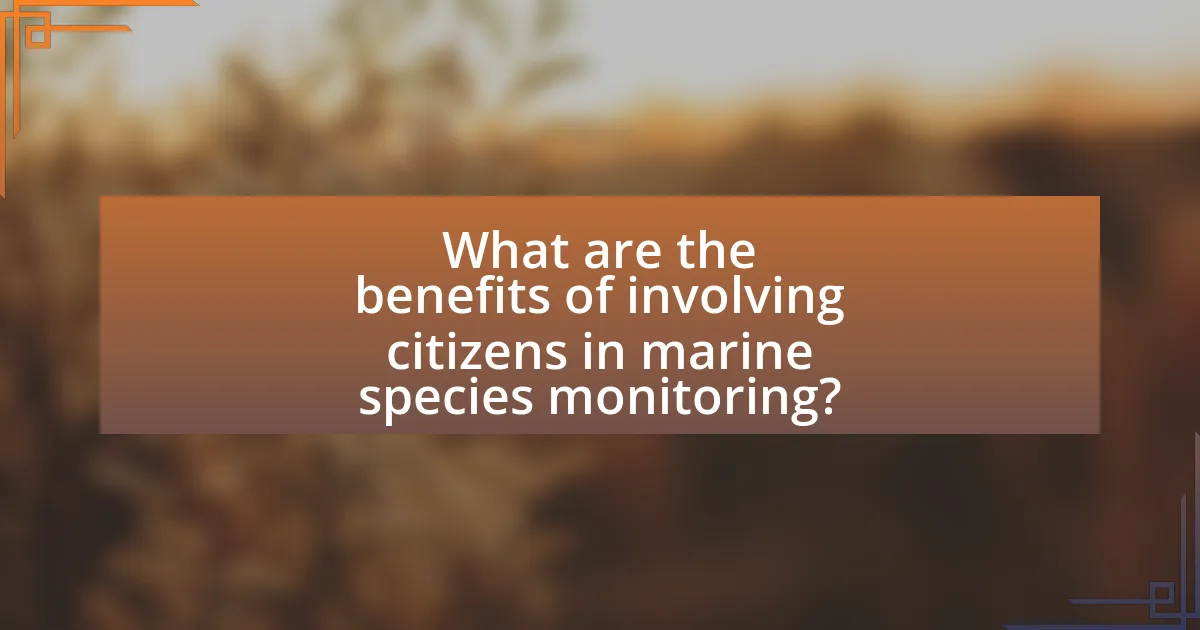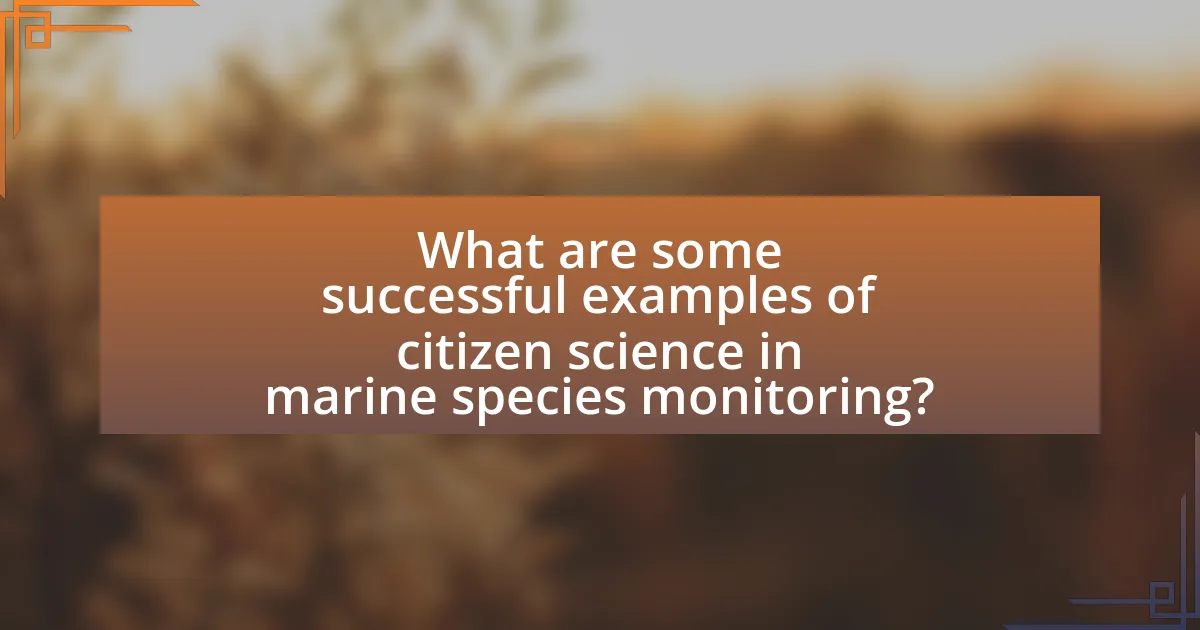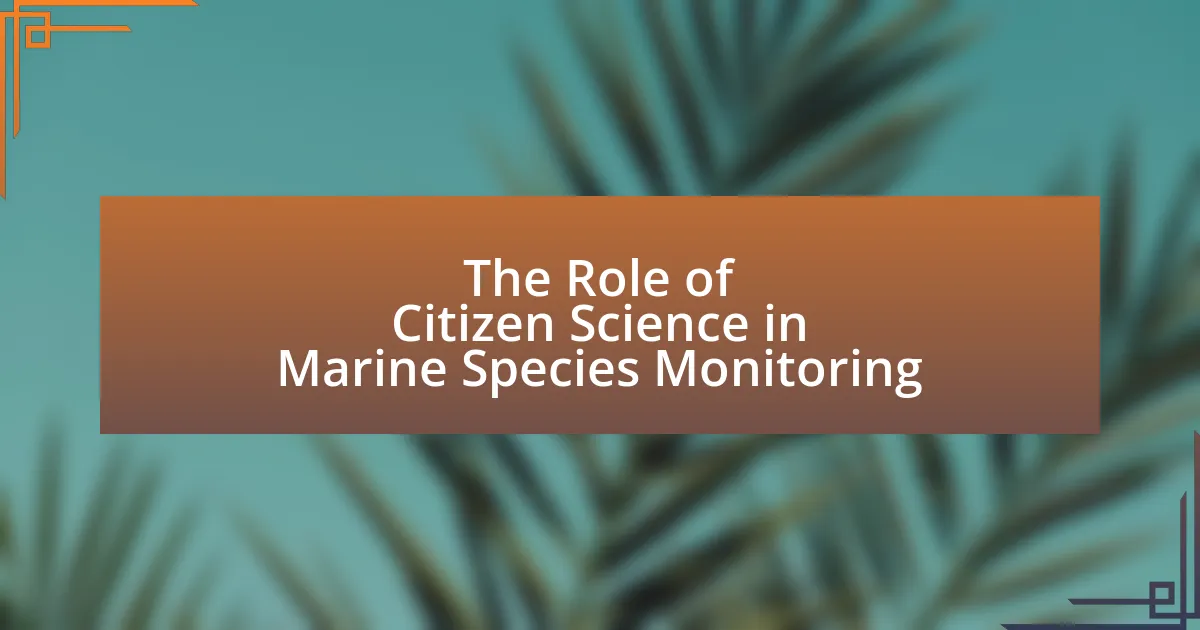Citizen science is a vital component of marine species monitoring, engaging the public in data collection and observation to enhance understanding of marine biodiversity. This collaborative approach allows researchers to gather extensive data across large geographical areas, improving species distribution models and informing conservation strategies. Key principles include collaboration, systematic data collection, and public engagement, which collectively foster community awareness and stewardship for marine ecosystems. Successful citizen science initiatives, such as the Reef Watch program and the International Coastal Cleanup, demonstrate the effectiveness of public involvement in gathering critical data for marine conservation efforts. The article also addresses challenges faced by citizen scientists and highlights future trends, emphasizing the role of technology in enhancing data collection and analysis for effective conservation strategies.

What is the Role of Citizen Science in Marine Species Monitoring?
Citizen science plays a crucial role in marine species monitoring by engaging the public in data collection and observation, which enhances the understanding of marine biodiversity. This collaborative approach allows researchers to gather large volumes of data over extensive geographical areas, often surpassing what is feasible through traditional scientific methods. For instance, initiatives like the Marine Biodiversity Observation Network have demonstrated that citizen-contributed data can significantly improve the accuracy of species distribution models and inform conservation strategies. Studies show that citizen science projects can lead to increased public awareness and involvement in marine conservation, ultimately fostering a more informed and engaged community regarding marine ecosystems.
How does citizen science contribute to marine species monitoring?
Citizen science significantly contributes to marine species monitoring by enabling non-experts to collect and report data on marine biodiversity. This approach expands the scope of data collection beyond traditional scientific methods, allowing for larger geographic coverage and increased frequency of observations. For instance, projects like the Ocean Conservancy’s International Coastal Cleanup mobilize thousands of volunteers to gather data on marine debris, which informs conservation efforts and policy decisions. Additionally, studies have shown that citizen-collected data can be as reliable as that gathered by trained scientists, enhancing the overall quality of marine monitoring initiatives.
What are the key principles of citizen science in this context?
The key principles of citizen science in the context of marine species monitoring include collaboration, data collection, and public engagement. Collaboration involves partnerships between scientists and non-scientists, allowing for diverse contributions to research efforts. Data collection emphasizes the systematic gathering of information by volunteers, which can enhance the scale and scope of monitoring activities. Public engagement focuses on educating and involving community members in scientific processes, fostering a sense of stewardship for marine environments. These principles are essential for effectively monitoring marine species and contributing to conservation efforts.
How do citizen scientists collect data on marine species?
Citizen scientists collect data on marine species through various methods, including direct observation, photography, and the use of mobile applications. These individuals often participate in organized projects that provide guidelines for data collection, such as recording species sightings, measuring physical characteristics, and noting environmental conditions. For instance, platforms like iNaturalist allow users to upload photos and location data, contributing to biodiversity databases. Research has shown that citizen science initiatives can significantly enhance species monitoring efforts, with studies indicating that data collected by volunteers can be as reliable as that gathered by professionals.
Why is marine species monitoring important?
Marine species monitoring is important because it provides critical data for assessing the health of marine ecosystems and informs conservation efforts. By tracking population trends, species distribution, and habitat conditions, researchers can identify changes that may indicate environmental stressors or biodiversity loss. For instance, studies have shown that monitoring programs can detect shifts in species populations due to climate change, overfishing, or pollution, enabling timely management interventions. This data-driven approach is essential for maintaining sustainable marine resources and protecting marine biodiversity.
What are the ecological impacts of monitoring marine species?
Monitoring marine species has significant ecological impacts, including improved biodiversity conservation and enhanced ecosystem management. By tracking population dynamics and health of marine species, researchers can identify trends that indicate ecosystem changes, such as shifts in species distribution due to climate change or habitat degradation. For instance, studies have shown that citizen science initiatives, like the Marine Conservation Society’s Beachwatch, have successfully documented changes in marine biodiversity, leading to targeted conservation efforts. Furthermore, monitoring can inform policy decisions, ensuring that marine protected areas are effectively established and managed, which is crucial for maintaining healthy marine ecosystems.
How does monitoring contribute to conservation efforts?
Monitoring contributes to conservation efforts by providing essential data on species populations, habitat conditions, and ecosystem health. This data enables conservationists to identify trends, assess the effectiveness of management strategies, and make informed decisions. For instance, a study published in the journal “Biological Conservation” found that citizen science initiatives significantly increased the amount of data collected on marine species, leading to better-targeted conservation actions. By engaging the public in monitoring activities, conservationists can enhance data collection while fostering community awareness and support for conservation initiatives.

What are the benefits of involving citizens in marine species monitoring?
Involving citizens in marine species monitoring enhances data collection, increases public awareness, and fosters community engagement. Citizen participation allows for the gathering of large-scale data over extensive geographic areas, which is often unattainable by professional scientists alone. For instance, studies have shown that citizen scientists can contribute to biodiversity assessments, leading to more comprehensive understanding of species distribution and abundance. Additionally, engaging citizens in monitoring activities raises awareness about marine conservation issues, promoting stewardship and encouraging sustainable practices within communities. This dual benefit of data collection and education ultimately supports more effective marine management strategies.
How does citizen involvement enhance data collection?
Citizen involvement enhances data collection by increasing the volume and diversity of data gathered, as well as improving the accuracy of observations. Engaging citizens in marine species monitoring allows for the collection of data across broader geographic areas and over extended time periods, which professional researchers may not be able to cover alone. For instance, a study published in the journal “Biological Conservation” found that citizen scientists contributed to over 60% of the data collected in certain marine biodiversity projects, demonstrating their significant role in enhancing data richness and reliability. This collaborative approach not only amplifies data collection efforts but also fosters community engagement and awareness regarding marine conservation issues.
What types of data can citizen scientists provide?
Citizen scientists can provide various types of data, including species observations, environmental conditions, and habitat assessments. These contributions are crucial for monitoring marine species, as they help gather real-time information on biodiversity and ecosystem health. For instance, citizen scientists often record sightings of marine life, which can be aggregated to track population trends and distribution patterns. Additionally, they may collect data on water quality parameters, such as temperature and salinity, which are essential for understanding the impacts of climate change on marine ecosystems. Studies have shown that data collected by citizen scientists can complement professional research, enhancing the overall understanding of marine environments.
How does citizen science improve public awareness and education?
Citizen science improves public awareness and education by actively engaging individuals in scientific research, thereby enhancing their understanding of marine ecosystems. Through participation in data collection and analysis, citizens gain firsthand experience and knowledge about marine species and their habitats. Studies, such as those published in the journal “Frontiers in Ecology and the Environment,” demonstrate that citizen science initiatives lead to increased environmental literacy, as participants learn about biodiversity, conservation efforts, and the impact of human activities on marine life. This hands-on involvement fosters a sense of stewardship and responsibility towards marine environments, ultimately promoting informed public discourse and action regarding marine conservation.
What challenges do citizen scientists face in marine monitoring?
Citizen scientists face several challenges in marine monitoring, including limited access to training, variability in data quality, and difficulties in engaging with local communities. Limited access to training can hinder their ability to accurately collect and analyze data, as many citizen scientists may lack formal education in marine science. Variability in data quality arises from differences in experience and expertise among volunteers, which can lead to inconsistencies in the data collected. Additionally, engaging local communities is often challenging due to varying levels of interest and awareness about marine conservation issues, which can affect participation rates and the overall impact of citizen science initiatives.
What are the common obstacles in data accuracy and reliability?
Common obstacles in data accuracy and reliability include human error, inconsistent data collection methods, and lack of standardized protocols. Human error can occur when citizen scientists misidentify species or record data incorrectly, leading to inaccuracies. Inconsistent data collection methods arise when different volunteers use varying techniques or tools, which can result in data that is not comparable. Additionally, the absence of standardized protocols can hinder the reliability of data, as it may not adhere to scientific rigor. These factors collectively undermine the integrity of data collected through citizen science initiatives in marine species monitoring.
How can these challenges be addressed effectively?
Challenges in marine species monitoring can be effectively addressed through the implementation of structured citizen science programs. These programs engage local communities in data collection, enhancing the volume and diversity of data gathered. For instance, a study by Bonney et al. (2014) in “Citizen Science: Theory and Practice” highlights that involving citizens can lead to increased data accuracy and coverage, as local participants often have valuable knowledge of their environments. Additionally, providing training and resources to citizen scientists ensures that data collection methods are standardized, which improves the reliability of the information gathered. This approach not only empowers communities but also fosters a sense of stewardship for marine ecosystems, ultimately leading to more effective conservation efforts.

What are some successful examples of citizen science in marine species monitoring?
Successful examples of citizen science in marine species monitoring include the Reef Watch program in Australia, which engages volunteers in monitoring coral reefs, and the Ocean Conservancy’s International Coastal Cleanup, where participants collect data on marine debris. The Reef Watch program has documented significant changes in coral health and biodiversity, while the International Coastal Cleanup has resulted in the removal of millions of pounds of trash from coastlines, providing valuable data on pollution trends. These initiatives demonstrate the effectiveness of citizen involvement in gathering critical data for marine conservation efforts.
How have specific projects utilized citizen science effectively?
Specific projects have utilized citizen science effectively by engaging local communities in data collection and monitoring of marine species, leading to increased data volume and public awareness. For example, the Reef Watch program in Australia empowers volunteers to monitor coral reefs, contributing to over 10,000 surveys that inform conservation efforts. Similarly, the Ocean Conservancy’s International Coastal Cleanup mobilizes thousands of volunteers annually to collect data on marine debris, resulting in actionable insights for policy changes and environmental protection. These projects demonstrate that citizen involvement not only enhances scientific research but also fosters a sense of stewardship for marine ecosystems.
What methodologies were employed in these successful projects?
Successful projects in marine species monitoring employed methodologies such as participatory data collection, standardized protocols, and the use of mobile applications for reporting sightings. Participatory data collection engaged citizen scientists in gathering information on marine species, enhancing data volume and diversity. Standardized protocols ensured consistency and reliability in data collection, allowing for comparability across different projects. Mobile applications facilitated real-time reporting and data submission, increasing engagement and efficiency. These methodologies have been validated through case studies demonstrating increased data accuracy and community involvement in marine conservation efforts.
What outcomes were achieved through these initiatives?
The initiatives in citizen science for marine species monitoring achieved significant outcomes, including increased data collection efficiency and enhanced public engagement in marine conservation. For instance, studies have shown that citizen scientists contributed to over 1 million observations of marine species, which provided valuable data for researchers and conservationists. Additionally, these initiatives fostered a greater awareness of marine biodiversity issues among participants, leading to a reported 30% increase in community involvement in local conservation efforts.
What future trends can we expect in citizen science and marine monitoring?
Future trends in citizen science and marine monitoring include increased use of technology, enhanced data integration, and greater collaboration among stakeholders. The proliferation of mobile applications and remote sensing technologies will empower citizen scientists to collect and share data more efficiently, leading to improved monitoring of marine ecosystems. For instance, platforms like iNaturalist and eBird have already demonstrated the effectiveness of community-driven data collection, which can be scaled up for marine environments. Additionally, the integration of artificial intelligence and machine learning will facilitate the analysis of large datasets, enabling more accurate assessments of marine biodiversity and health. Collaborative efforts between researchers, governmental agencies, and local communities will further enhance the effectiveness of citizen science initiatives, as seen in projects like the Ocean Conservancy’s International Coastal Cleanup, which mobilizes volunteers globally to monitor and reduce marine debris.
How might technology influence citizen science in marine contexts?
Technology significantly enhances citizen science in marine contexts by providing tools for data collection, analysis, and sharing. For instance, mobile applications enable volunteers to record sightings of marine species, contributing to databases like iNaturalist, which has over 30 million observations. Additionally, remote sensing technologies, such as drones and underwater cameras, allow for the monitoring of marine habitats and species without disturbing ecosystems. These advancements facilitate real-time data collection and improve the accuracy of citizen-reported information, as evidenced by studies showing that citizen-collected data can match the quality of professional data in marine biodiversity assessments.
What role will citizen science play in future conservation strategies?
Citizen science will play a crucial role in future conservation strategies by enhancing data collection and public engagement in environmental monitoring. This approach allows non-professionals to contribute valuable observations and data, which can significantly increase the volume and diversity of information available for conservation efforts. For instance, studies have shown that citizen science initiatives, such as the Marine Conservation Society’s Beachwatch program, have successfully gathered extensive data on marine litter, influencing policy changes and conservation practices. By leveraging the collective efforts of the public, conservation strategies can become more adaptive and responsive to real-time ecological changes.
What best practices should citizen scientists follow for effective marine monitoring?
Citizen scientists should follow standardized protocols, utilize proper equipment, and ensure data accuracy for effective marine monitoring. Standardized protocols, such as those developed by organizations like the Ocean Conservancy, provide guidelines for data collection, ensuring consistency across different monitoring efforts. Proper equipment, including GPS devices and water quality testing kits, enhances the reliability of the data collected. Additionally, maintaining data accuracy through regular training and calibration of instruments is crucial, as studies show that accurate data collection significantly impacts the effectiveness of marine conservation efforts. For instance, a study published in the journal “Frontiers in Marine Science” highlights that citizen-collected data can be as reliable as that collected by professionals when proper methodologies are followed.
